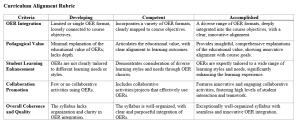Chapter 2 – Accepting
In this chapter, you will demonstrate how effectively you can integrate Open Educational Resources (OER) into your curriculum. The alignment of OERs with your course objectives is critical in ensuring that they enhance the learning experience, meet diverse student needs, and support collaborative learning environments.
Your course syllabus should showcase the following:
- OER Integration: Incorporate a variety of OER formats (e.g., texts, multimedia, interactive tools) that are well-mapped to your course objectives. Clearly define how each OER resource enhances the learning goals.
- Pedagogical Value: Articulate the educational value of the chosen OERs, ensuring alignment with your course’s intended learning outcomes. Highlight how the OERs will support and enrich your teaching strategies.
- Student Learning Enhancement: Demonstrate how OERs address diverse learning styles and needs. Your syllabus should illustrate how the resources provide opportunities for personalized learning and inclusivity.
- Collaboration Promotion: Incorporate collaborative activities or projects that effectively utilize OERs to foster student interaction and teamwork.
- Overall Coherence and Quality: Ensure your syllabus is well-organized and that the integration of OERs is clear, purposeful, and enhances the overall learning experience.
Submission Instructions:
Please submit your course syllabus using the form embedded below. Your submission will be reviewed and assessed based on the rubric provided. This rubric evaluates your alignment of OERs with the course objectives, the pedagogical value of your resources, and the overall coherence of your syllabus.

Once your syllabus has been reviewed against this rubric, you will receive feedback and may proceed to Chapter 3 – Adapting.

